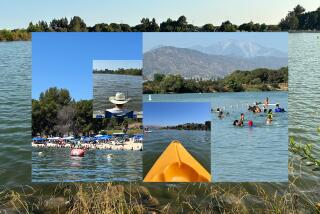At a Remote Forest Lake, Monstrous Legends Spawn
- Share via
Lake Elizabeth’s surface is smooth. No scorched trees in the surrounding forest, not a single giant footprint on shore.
But you’ve driven 30 minutes along windy mountain roads to this lake in the Angeles National Forest. You’ve got to ask. Try the men casting into the dark waters.
“Ever seen a dragon in the lake?”
Long silence.
“Been fishing here for 25 years, and I’ve never seen nothing like that,” the one with the camouflage vest says, pushing his toe into the gray sand beneath his feet and looking at you like you’re holding a crayon and coloring book, not pen and pad.
You cross Elizabeth Lake Road, the dust kicking over your shoes, to the Rock Inn, a cobblestone building with iron bars across the windows. Perhaps somebody here will know.
“Nah, nothing like that in there,” the waitress at the Rock says over the football game playing in the background, writing down your order and pivoting on the dark wood floor back toward the kitchen.
Of course not. It’s just a legend, some fanciful tale you heard once. You’re better off asking if Elvis has left the building. Just go home and quit believing everything you hear.
But since you’re here, maybe just one more guy, the bald man with the big salt-and-pepper sideburns behind the bar.
“Hey, you ever heard of a dragon in the lake?”
He lets your question linger a minute, folding his arms across his chest, as if preparing to impart a big secret.
“I think it was shot in Tucson in 1910 or 1912,” says Larry Martin, who owns the joint.
Since the days of the Spanish explorers, there have been stories of a dragon in Lake Elizabeth, which is located along the San Andreas Fault about 30 miles north of Santa Clarita.
Some people, like Martin, believe the dragon was shot in the early part of the century.
Fred, a man sitting at the end of the bar with his reading glasses slung low and People magazine spread wide open, claims to have laid eyes on the creature.
“You can still see her on the eastern end of the lake,” he says.
According to legend, the monster is anywhere between 18 and 30 feet long, blue or green, smells sulfurous, has a fondness for raw cattle and--according to Martin--sports a “tyrannosaurus neck.”
Some say the legend has faded away as the population around the lake has grown from a handful of settlers to 4,000 or so residents. And the story itself is not that surprising--lake monsters are a fairly standard part of oral literature, experts say.
Well-known examples include the Loch Ness monster and Champ, a creature that supposedly lives in Lake Champlain, N.Y., said Sabina Magliocco, an assistant professor of anthropology at Cal State Northridge.
“When you don’t know what’s at the bottom of a lake, every log and ripple becomes mysterious and has to be explained. A monster was a pretty easy way to do it,” she said.
Stories about such monsters were typically passed on through word of mouth, much the way Martin tells his tale from behind the counter at the Rock Inn, a cavernous, darkly wooded bar/restaurant where locals can toss back rum-and-Cokes in the early afternoon while calling each other by their first names.
As Martin, who’s lived in the area since the 1960s, tells it, a Spanish explorer was leading his troop along a well-worn trail by Lake Elizabeth when they got stuck.
The Spaniard sold his soul to the Devil in exchange for a road. After the road was built, the leader decided he wanted to keep his soul a bit longer and told the Devil the deal was off.
Miffed, Satan created the lake and furnished it with the dragon--which terrorized settlers and devoured cattle periodically for the next two centuries.
At this point, a few afternoon drinkers who were talking about the previous night’s car crash in front of the Rock come over to listen to the tale. Martin’s voice picks up pace, his bristly sideburns bouncing as he speaks.
“It lived there until 1910 or 1912, not exactly sure which, and then there were these farmers in Tucson who shot it. There was a picture in the paper out there, I don’t remember which one . . .”
Whoa. Tucson? Arizona? How’d it get there?
“It flew,” Martin says simply, an eyebrow raising in a “how-else-would-it-get-there?” expression.
The roadhouse owner catches himself. “Supposedly,” he adds, shrugging his shoulders deeply and wiping his hands on his apron again.
Martin says the legend was alive and well during the 1960s. That was when the homes were mostly small and made of wood, there was just one telephone line, and swapping stories “was just a part of life,” he says.
“Used to be you knew everyone here, there were only 13 houses, and the story was part of the mix because it was everywhere,” Martin says.
While the roads are still mainly unpaved, modern homes have begun springing up on the east side of the lake, and fewer people are steeped in local history, Martin says. “The story has died over generations,” he adds.
But others say the old tales persist through other means. Instead of being told around the campfire, tales are passed along via books, movies and the Internet, academics say.
Print has its drawbacks, academics say. A skillful storyteller would have a mental Rolodex of possible story endings or scenarios and could change the tale to suit an audience. For example, “the wolf could eat Little Red Riding Hood” instead of Little Red Riding Hood slaying the wolf, depending on the speaker’s mood, said Gene Cooper, a professor of anthropology at USC who studies Chinese folklore.
“Once a story goes into print, it solidifies them and you can lose a lot of the meanings it once had,” Cooper said.
But folklore experts say monsters are increasingly finding an audience in cyberspace, which has countless sites devoted to unexplained mysteries. The Internet is “tailor-made for the dispersal of folk tales,” Cooper said. “Rather than being passed along from father to son once a generation, they get passed along to everyone on your mailing list and it puts more material in peoples’ hands that they can work with and spice up.”
Angeles National Forest officials try to keep a straight face at the notion of a dragon in Lake Elizabeth, which is less than 100 feet deep and occasionally goes dry during the summer. While much of the lake is surrounded by brush and pine, homes do overlook the eastern edge. As Bruce Quintelier, a spokesman for the forest, pointed out: “Not a lot of places to hide.”
But some locals aren’t as dismissive. Devin Peterson has spent four or five nights by the lake in the last several years and swears he’s heard ducks screaming each time, as if something were chasing them. “Nothing would surprise me,” he says, pacing the lake shore, the sand crunching under his feet.
“Ducks don’t scream like that for no good reason.”
More to Read
Sign up for The Wild
We’ll help you find the best places to hike, bike and run, as well as the perfect silent spots for meditation and yoga.
You may occasionally receive promotional content from the Los Angeles Times.







